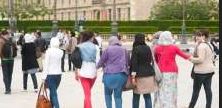French School Deems Teenager’s Skirt an Illegal Display of Religion

A secondary school in northeastern France has sent a 15-year-old student home twice in the last two weeks for wearing a long skirt that the principal judged was “an ostentatious sign” of the girl’s Muslim faith.
The case has lit up social networks in France and infuriated many of the country’s Muslims, who see the school system’s censure of the girl as discriminatory.
A law adopted in 2004 forbids elementary and secondary school students to wear visible signs of their religious affiliation to school, including skullcaps for Jews, noticeable crosses for Christians and head scarves for Muslims. School officials, though, are increasingly construing the ban to apply to articles of clothing like long skirts and headbands, in ways that appear to vary from school to school.
“It’s a huge problem,” said Elsa Ray, a spokeswoman for the Collective Against Islamophobia in France.
The principal at the Léo Lagrange school in Charleville-Mézières decided that the black maxiskirt the girl wore ran afoul of the rules and wrote to the girl’s parents that their daughter had been sent home to change into more appropriate attire.
Ms. Ray called it “really an excessive interpretation” of the law.
The collective has documented 130 similar cases across France since January 2014, and Ms. Ray said they were becoming more frequent. The cases often involve skirt length, she said, but schools have also objected to sweaters or to headbands that they say are too broad and are meant to evoke head scarves.
Because the girl in Charleville-Mézières is a minor, she has been identified in French news reports by only her given name and initial, Sarah K. Her case points to the difficulty in enforcing the French policy of laïcité — roughly, secularism — which strives to keep religion strictly out of government and the public sector. It has been invoked in recent years to restrict the places where Muslim women can wear clothing concealing their bodies or faces.
The New York Times










